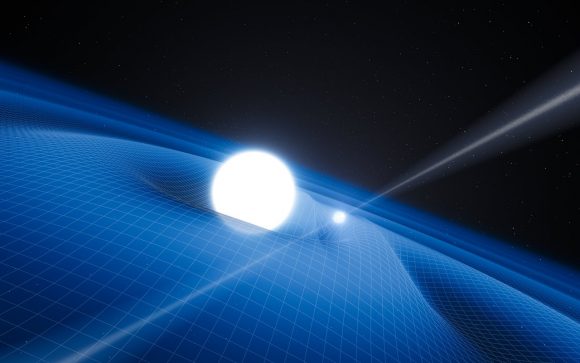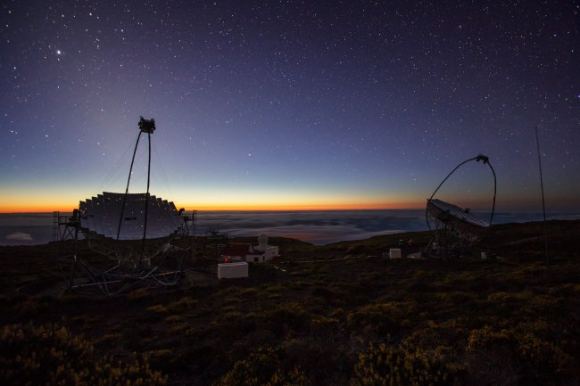Neutron stars are one of the most fascinating astronomical objects in the known Universe. In addition to being the densest type of star (with the possible exception of quark stars), they have also been known to form binary pairs with massive stars. To date, only 39 such systems have been discovered, and even fewer have been detected that were composed of a massive star and a very high energy (VHE) gamma-ray neutron star.
To date, only two of these systems have been found, the second of which was discovered just a few years ago by a team of international astronomers known as the Very Energetic Radiation Imaging Telescope Array System (VERITAS) collaboration. In addition to being a rare find, the discovery was also very fortunate, since the unusual behavior they observed coming from this system will not be happening again until 2067.
Simply put, neutron stars are the dense remains of a star that has exploded in a supernova, leaving behind an extremely dense, compact object that spins rapidly. This causes a neutron star to generate powerful magnetic fields that focus its radiation into a tight beam, which appears like a lighthouse when viewed edge-on. When these beams intersect with Earth, astronomers can detect these pulses at radio and other wavelengths.

Since it is common for massive stars for form binary pairs, it is not surprising that some pulsars have an orbiting companion that survived its partner going supernova. It is also common for these systems to have debris disks, which are affected by the rapidly spinning pulsar. As radiation collides with debris, it creates charged particles that can be accelerated to nearly the speed of light, resulting in very high energy (VHE) gamma rays.
Using the four 12 m telescopes at the Fred Lawrence Whipple Observatory, which is operated by the Smithsonian Astrophysical Observatory (SAO), the VERITAS collaboration began tracking what was thought to be a VHE gamma-ray pulsar system back in 2016. This source is located in a massive stellar nursery about 5000 light-years from Earth in the direction of the Cygnus constellation.
With the help of a team of astronomers who used the two 17 m Major Atmospheric Gamma Imaging Cherenkov (MAGIC) telescopes (located at the El Roque de Los Muchachos Observatory in the Canary Islands), the team found that the pulsar had a massive stellar companion that orbited it every 50 years in an extremely elliptical orbit. The two teams also calculated that the stars would be at the closest points in their orbit by Nov. 13th, 2017, and would not be again until 2067.
The directors of the VERITAS collaboration had previously entered into participation with other astronomers to monitor this system before, during and after its closest approach. Using the Fred Lawrence Whipple Observatory’s four telescopes, they detected the gamma-rays from the extremely brief flashes of Cherenkov radiation that appear in the skies when they are absorbed by Earth’s atmosphere.
Initial observations, conducted in 2016, revealed weak gamma-ray emissions, which were consistent with the fact that the binary system in embedded in a stellar nursery. “This low-level, steady emission is most likely from a nebula which is being continuously powered by the pulsar,” said Ralph Bird, a post-doctoral researcher at the University of California Los Angeles who played a leading role in the VERITAS campaign.
The scientists therefore waited for the stars to reach the closest point in their orbit to see if there would be any change. According to Alicia López Oramas, a researcher with MAGIC at the Instituto de Astrofísica de Canarias (IAC), and one of the corresponding authors of the study, “such a unique system was expected to emit very-high-energy gamma rays during this approach, and this opportunity could not be missed.”
By September, things began to change drastically. As Tyler Williamson, a graduate student from the University of Delaware’s Department of Physics and Astronomy and another key contributor to VERITAS, indicated:
“The gamma-ray flux we observed in September was twice the previous value. During the closest approach between the star and the pulsar, in November 2017, the flux increased 10 times in just a single night.”
In order to explain this behavior, the team matched theoretical models based on the latest theories about pulsars, debris disks and the resulting emissions to their observations. This proved unsuccessful, which led them to conclude that significant revisions are needed, which includes better information about the encounter between the two stars.

In short, more observations of this binary pair are needed before proper modelling can be made. This is not surprising since this system is only the second case of a binary pulsar system exhibiting VHE gamma-ray emission. Nevertheless, the observations collected by the two teams were invaluable, given that all previous explanations about the behavior of VHE gamma-ray pulsar binaries was speculation.
In the coming years, the scientists plan to continue to observe this and other pulsars to monitor the exotic behavior coming from this extreme type of object. And if proper models can be developed for this particular system, it will be of immense value to scientists, offering insight into the birth and evolution of compact objects – ranging from pulsars to binary black hole systems.
As Wystan Benbow, an astrophysicist with the CfA, stated, “continued investment in the operation of unique, leading edge facilities like VERITAS is critical and will ensure further opportunities to achieve transformative science.”
The VERITAS collaboration is a group of 80 scientists from 20 institutions based in the United States, Canada, Germany and Ireland. The study which describes their findings recently appeared in the Astrophysical Journal Letters. The Fred Lawrence Whipple Observatory is operated by the Smithsonian Astrophysical Observatory’s (SAO).
Further Reading: CfA

